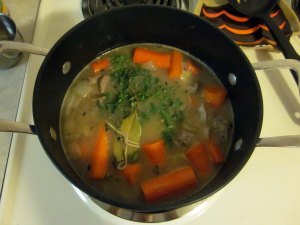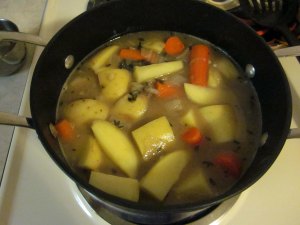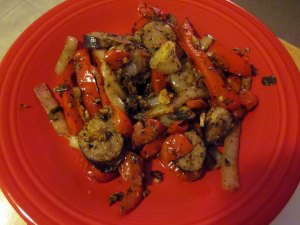I went to a butcher shop for the first time to buy some lamb for this stew. It was great. I felt like I was in a Dickens novel, visiting Mr. Hackbottom, the butcher, for some mutton, then Mrs. Frickelby for some currants to put in my mincemeat. I’ve never thought of raw meat as looking healthy, at least not before setting foot in the butcher’s shop. Everything was so pink and glistening and fresh-looking. I circled around the circumference of the store with my mouth hanging open in awe, like an orphaned street urchin setting foot in a candy store for the first time, nickel in hand. I only made it halfway around and was staring eye to eye with a giant shrimp when someone came over and asked if he could help me. I asked for lamb, expecting them to only maybe have some kind of filet. He walked me over, explaining that they have lamb loins, ground lamb, lamb for stew, lamb shoulder, and a lamb leg the length of my arm. I’m pretty sure you have to have a special platinum chef’s card saying, “I know what this is! I know how to cook it!” before they will let you buy a lamb leg. I had never cooked with lamb before, and since I was making a stew, I went with the lamb for stew. Safe bet, plus it was already cut up into nice little chunks. Score.
I’ve only eaten lamb a couple of times and I’d never made a stew before, so this whole experience sort of felt like walking out on a thin branch above a lake full of alligators. I re-read the recipe at least a dozen times, afraid of missing something important. It seemed too simple for something like lamb. Actually, it was that simple. Sweat the onions, brown the lamb, add the herbs, carrots, and chicken stock, then wait. And wait. Add potatoes. And wait.
I added the potatoes after 2 hours of cooking, and thought I’d test the meat to see if it was cooked. I tried to pull a very small bite off a piece of lamb, but to my surprise, it was tough, resembled leather, and was impossible to separate from the rest of the meat. I was downtrodden and discouraged, thinking this was going to end up being the worst thing I’d ever cooked. Still, I waited.
I had the stove on the lowest setting, and the pot didn’t seem very warm, so after adding the potatoes, I turned the heat up a little and decided to let it cook another hour instead of just 30 minutes, hoping that would make the meat more tender. An hour later, I was busy doing other things and decided to just let the pot keep cooking until I was ready to eat. It ended up cooking a little over 4 hours in total. I think this was a smart move, because when I finally did eat the stew, the meat was so much more tender than it had been 2 hours earlier. It easily broke apart with a spoon and lost all the toughness it previously displayed. I guess time really does heal all wounds.
This stew has a really wonderful flavor and the thyme is definitely prominent in all the best ways. The broth is so flavorful that I enjoy just sipping it straight out of the bowl by itself. The carrots and potatoes are delicious, but I’m just glad that the meat lost its toughness and took on the taste of the broth. Adding fresh chives just before serving may seem insignificant, but I really think it’s a must. It complemented everything else in the stew so well and added a tiny bit of crispness and fresh color to the dish. The best part of the whole process: the smell. From the moment I seared the meat and added the chicken stock, it smelled incredible. Being able to smell the stew cooking all day long made the long wait tolerable, and ultimately worthwhile. I’ve never been big on cooking or eating soups, but after this experience, I might just try my hand at soups more often.
It says this serves 6 people, but those must be 6 huge servings. I cut this recipe in half, and half the recipe looks like 6 servings to me.
Ingredients
- 2 medium-sized onions, chopped
- Oil, for frying (I used 1 tablespoon)
- 1-ounce butter
- 1 sprig dried thyme (I used fresh thyme instead)
- 2 1/2 pounds best end of lamb neck, cut into large pieces
- 7 carrots, chopped lengthways into 2-inch pieces
- 2 tablespoons pearl barley
- 5 cups chicken stock, recipe follows
- Salt
- Freshly ground black pepper
- 1 bouquet garni (parsley, thyme, and bay leaf)
- 12 medium potatoes
- 1 bunch parsley, leaves finely chopped
- 1 bunch chives
Directions
In a large heavy-bottomed saucepan, cook the onions in oil and butter, on medium-high heat until they are translucent. Add the dried thyme and stir. Add the lamb and brown on a high heat to seal in juices. Add carrots, and pearl barley. Pour in the chicken stock so that it almost covers the meat and vegetables. Season with salt and pepper, and add Bouquet garni. Cover and cook on low heat for 2 hours, being careful not to boil. Place potatoes on top of the stew, cover and cook for 30 minutes until the meat is falling beautifully off the bones and the potatoes are fork tender.
Serve the stew in large flat soup bowls, and drizzle herb butter over the potatoes or garnish with parsley and chives.



















